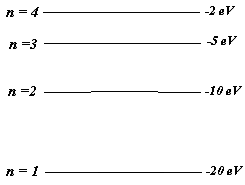Below is an energy level scheme of a hypothetical one-electron element Mathematicum. The potential energy is taken to be zero for an electron at an infinite distance from the nucleus. (a) How much energy does it take to ionize an electron from the first excited state? What will be the value nf of the final electron state if a photon of energy of 8 eV strikes a Mathematicum atom initially in its first excited state level? (b) What will happen if a photon of energy of 7 eV strikes a Mathematicum atom in its ground state level? Explain what happens. (c) Will photons emitted in the Mathemticum transitions n = 4 to n = 3
Below is an energy level scheme of a hypothetical one-electron element Mathematicum. The potential energy is taken to be zero for an electron at an infinite distance from the nucleus.
(a) How much energy does it take to ionize an electron from the first excited state? What will be the value nf of the final electron state if a photon of energy of 8 eV strikes a Mathematicum atom initially in its first excited state level?
(b) What will happen if a photon of energy of 7 eV strikes a Mathematicum atom in its ground state level? Explain what happens.
(c) Will photons emitted in the Mathemticum transitions n = 4 to n = 3 eject photoelectrons from a certain metal? The work function Φ of the metal is 2.94 eV. The work function is the minimum photon energy needed in order for an electron to escape the metal. Will electrons be ejected from the metal by the photons? Answer yes or no and explain why. If yes, what is the kinetic energy of the ejected electrons?

Trending now
This is a popular solution!
Step by step
Solved in 3 steps
